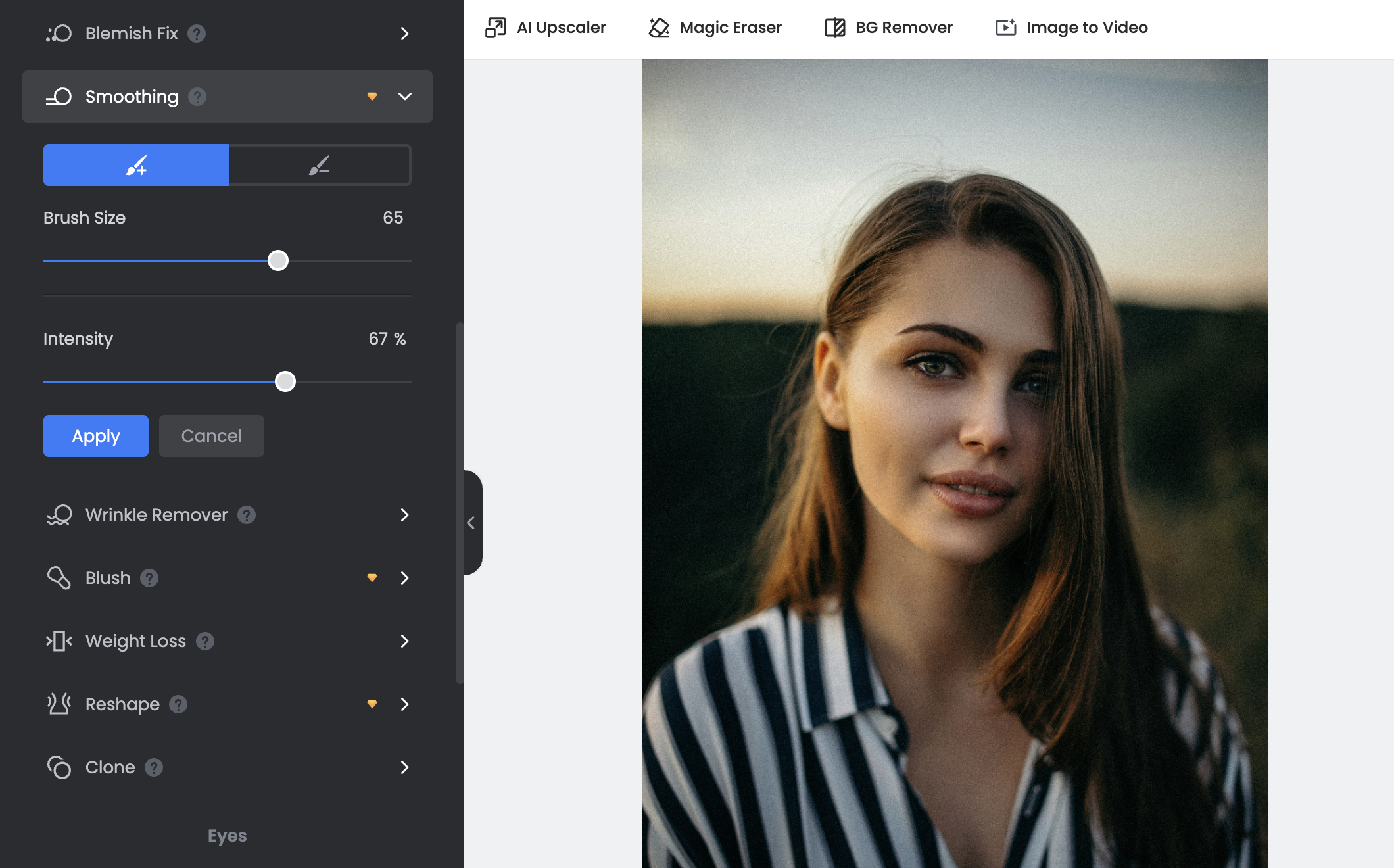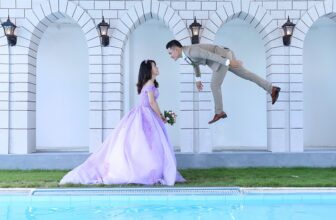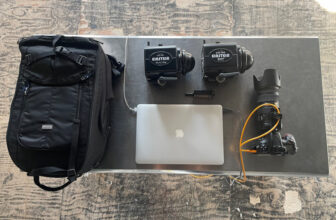
I tried using AI-based tools to retouch portraits and found that the results were stunning and, of course, fast.
The option to hand over manual editing tasks like portrait retouching to my personal AI helper delights me.
AI can automatically identify and correct blemishes, soften wrinkles, and straighten crooked teeth.
This means that with a few clicks, photographers can enhance a photo that previously took a lot of time and skill to edit.
People of all skill levels can utilize these powerful AI tools. You don’t need training, and you don’t need an expert artist’s eye.
All you need is a portrait photo and access to an AI enhancement app. Are you ready to give it a go?
Creating Stunning Portraits with AI Retouching Tools
AI is transforming how photographers approach portrait retouching, and personally, I’m embracing the change with wide-open arms.
Manual editing provides superior control over the final result, but AI is continually trained, and with each passing day, it acquires more skills.
AI databases are being increased with additional content, such as facial structures and skin tones, meaning it can more knowledgeably discern when and where to make adjustments.
AI can’t help itself; it’s capable of speed and focus that we can never aspire to, nor do we need to.
AI understands the contours of the face and how to enhance it to look both natural and glamorous.
Let’s dive in and see how we can use its undeniable skill to our advantage and enhance portraits.
My Go-To AI Portrait Enhancement Adjustments
When I start, I usually get the simple edits out of the way, cleaning up the glaringly obvious.
The first step I take when enhancing a portrait is removing skin blemishes. Once the skin is cleared of defects, I adjust the skin tones.
Next, whiten teeth, remove red-eye, and soften wrinkles.
In very rare cases, I might need to open eyes, for those precious family photos where just one person has blinked, and everyone else looks fantastic.
The last steps include sharpening the image if it’s out of focus or blurring the background if it’s distracting.
Sometimes, a model may need a makeup adjustment, like extra blush, a lipstick color change, or additional eyeshadow.
For fun, you can change your age, swap your gender, or lose weight, and possibly you can add some if you want to plump out your cheeks.
There are many AI apps tailored to meet your portrait enhancement needs; you can take your pick and find the one that suits you.
Let’s look at these steps in a bit more detail.
Removing Skin Blemishes
First step, I check the skin for blemishes. I will, of course, check with my client if this is something they want.
I don’t want to assume that features such as birthmarks or moles need to be removed, only to find out later that I have offended the client.
The same is true for freckles; it is very rare for a client to ask to have freckles removed.
I love my freckles and wouldn’t want to remove them, but if you do want to remove yours, AI will jump to your editing service and remove them for you.
The most common request is to remove acne, scars, or liver spots. Plus, sometimes tattoos.
Once the portrait has been edited to feature clean, flawless skin with no blemishes in sight, I will then begin the skin smoothing process.
Skin Smoothing and Toning
Smoothing skin used to involve carefully planned brush strokes. It’s easy to smudge or leak one area of skin tone into another.
This definitely was one of my least favourite (and still is) editing tasks. Zoom in, and the image looks perfect; zoom out, and you’ve created a monster.
Why would I torment myself touching up skin tones when AI is so capable?
AI can detect skin areas in a photo and smooth them using its intelligent algorithms, creating a natural skin texture while avoiding the overly edited, plasticy look.
Portrait touch-ups that go too heavy on the editing brush can start to look plastic and artificial.
Not a popular look unless you’re planning to mimic Barbie.
To avoid this, AI algorithms consider the skin’s organic texture, preserving its natural appearance.


In the image above, one model was reflecting the studio lights, resulting in an unnatural, gleaming skin.
Using YouCam’s AI portrait enhancement tools, it was possible to quickly remove the shine.
The process? Open the image in YouCam and click ‘Shine removal.’ Then slide the adjustment slider to decrease or increase the strength of the edit until the shine is removed.
Whiten Teeth and Remove Red Eye
When I am happy with the skin tones, I proceed to check for colored or crooked teeth and red eyes.
Correcting teeth is an uncomplicated procedure. Just watch that the teeth don’t become unnaturally white, lose any definition, and that the eyes don’t change color.


Free AI photo editing apps like Fotor offer a huge range of portrait enhancement tools.
When whitening teeth, Fotor will ask you to select a brush and paint over the teeth.
This may seem like one too many steps, considering it is AI, but brushing over the tooth area helps the AI focus on the correct area.
Otherwise, you might find an unwanted set of teeth, where AI has extended teeth fixing capabilities to areas you don’t want fixed.
Trust me, whitening teeth manually involves zooming in and selecting the correct white colors with a fine toothpick.
Color Balance and Light Adjustments
Next, I adjust the overall lighting of the portrait. Usually, this involves checking the white balance, levels, and saturation.


Now that AI is on the scene, I like to use its automatic adjustments, just to try them out to see how they look.
Below is an example of AI adjustments applied to a photo I took in Vietnam. This was using the app Clipdrop.


Okay, Clipdrop is possibly not the most advanced AI app. For more professional results, use an AI photo editing app like Luminar Neo.
However, I prefer to complete this step manually for two reasons. One reason is that I like to maintain creative control.
Although adjusting light levels may not seem like the most artistic or creative aspect of a portrait, it has a significant impact on the final image.
The second reason is that I don’t want to become lazy. If I rely on AI to fix exposures, I believe I will lose my trained eye.
Instead, I use AI to provide a preview of possible adjustments, allowing me to decide how I want to adjust the photo.
For example, when a client requests a vibrant portrait or a romantic mood, I can apply AI lighting and filters to preview what works best.
A good lighting adjustment will be consistent while maintaining the mood of the photo.
What you don’t want is areas where the face is more saturated, while the background is flat; this will make it appear as if the subject was pasted onto the background.
When adjusting the lighting, what you want to maintain is the overall consistency of light tones throughout the photo.
Virtual Makeup and More
If your model forgets her mascara or her lipstick doesn’t match her outfit, you can apply AI to quickly remedy the situation.
Digital makeup is great for people whose portrait looks flat and lacks definition.
Makeup simulation is a fantastic tool, whether you want to add subtle makeup or vamp it up with dramatic alterations.


As you can see in the image above, YouCam has an AI virtual makeup application. It’s super easy to use: select the type of makeup you wish to apply, such as blush or eyeshadow, and then choose a color.
AI makeup application can also help test design ideas. Using AI photo editing apps, you can even test or apply different hairstyles.
Unfortunately, when major adjustments are made to AI apps, AI often takes the liberty to adjust more than just the hairstyle.


As you can see in the image above, the hairstyle was changed, but so too was the model.
The hairstyle looks excellent, and if you don’t mind that AI also changes the subject, then great, enjoy!
However, more often than not, we prefer to keep our model’s expression, facial features, and position intact.
If you think only AI hairstyles are popular, think again; beards are also an option.
AI Feature Enhancement
Another interesting AI tool is facial feature enhancement.
This is used to subtly enhance the subject’s natural beauty. Now we know why celebrities don’t look quite as hot in real life!


Eyes and lips can be enlarged, cheekbones raised, and facial contours adapted.
This isn’t something I am asked for often, and when I have been asked, it is very slight alterations.
And if it means someone is happy with their portrait appearance, why not? It might save them from heading to get a slice of the knife or paying for regular fillers.
AI Funky and Fun Portrait Enhancement
Now, let’s not finish up here; there is so much more you can try when using AI apps.
We’re now heading into the experimental editing terrain. This type of ‘enhancement’ would be considered AI generation rather than editing.
Fotor is an AI photo editing app that offers the option to alter your age. Sadly, not in reality, just virtually.


Click on the age you wish to jump to, and AI will take you there.
There are many other quirky AI adjustments to try. Why not give yourself a muscular torso, swap your gender, or lose weight?
Anything is possible when you go virtual.
Review and Go
I strongly advise that you review your portraits after edits to ensure consistency and accuracy of the eye color.
Check AI edits, such as teeth whitening, to ensure that the teeth haven’t been merged together.
When you are happy with the adjustment, you can unleash the batch processor.
This saves you bucket loads of time, not just moments.
It’s ideal for photographers who do weddings or fashion shoots, as it allows them to edit multiple images simultaneously.
Standard photo editing programs, such as Photoshop and Lightroom, have incorporated AI batch processing, allowing you to add filters, upscale images, and more.
Hot AI Portrait Enhancement Apps to Try


Luminar Neo for portrait editing. Credit: Skylum
The most popular AI portrait retouchers have emerged as the leaders, forging the path for others to follow.
The AI app Retouch4me has been designed with the professional retoucher in mind.
It covers the basics while giving editors the option to manually tweak the edits to their exact specifications.
For example, it incorporates dodge and burn effects for professional editors who wish to have ultimate control and tweak the final edit to their liking.
You can read our full review of it here.
Luminar Neo has you covered on all enhancement fronts, from lighting and face sculpting to skin retouching.
You can sign up to avail yourself of their incredibly intuitive interface and access to powerful AI tools.
Fotor is an option for novices who want to take advantage of one-click wonders. Dive in to adjust your photos in a split second to Vogue model standards.
This is automated for a smooth user experience, perfect for the beginner.
However, if you wish to have control over the final adjustments, Fotor might not be the option for you.
PhotoDiva, YouCam, Clipdrop, and many other AI photo editing apps are available online for free, allowing you to experiment with them.
These AI apps are like Fotor, great to use if you don’t intend to tweak the result manually.
Don’t forget that you can use Adobe software, including Lightroom and Photoshop, for AI editing, as they have incorporated AI adjustments.
Adobe Suite keeps up with the editing trends and the latest AI tools. Tools that don’t interfere with the creative process but facilitate it.
As such, Photoshop users can make a smooth transition from advanced AI automation to manual control.
The best AI apps for professional portrait editors seamlessly combine the best of manual editing with AI.
AI is powerful, concise, and has the ability to pinpoint areas that need correction.
However, editors who require professional edits know that you can’t simply wave the AI magic wand and trust that everything will be perfect.
Control vs Automation: Striking a Balance
Striking the healthy, creative balance between automation and editing control is up to you.
Personally, I like to keep the creative reins clasped firmly in my hands.
You, on the other hand, might be happy for AI to do the entire touch-up; your focus might be on the clothing, the expressions, or the composition.
When using AI apps, such as Luminar Neo, you have the option to step in and fine-tune the results.
This allows you to keep ‘control’ – AI can get you most of the way there, and you can reign it in a notch or two.
I let AI do the initial work because menial tasks consume too much of my precious time.
My editing strengths and areas of interest lie on the creative rather than the mechanical side.
History of Portrait Editing
AI-retouching tools will streamline your workflow and elevate your image quality. All in the snap of a finger.
Traditionally, when you took a photo with an analog camera, there were very limited options to edit photos.
As a result, when shooting portraits, photographers relied heavily on lighting.
They would ensure the lighting was creamy, perfect, and softly glowing to bring out the best in their subjects’ skin.
Specialized lenses were used to achieve different looks. A soft focus lens was used to hide wrinkles or create a romantic ambiance.
Below is a photo taken using a soft focus lens, which creates a dreamy atmosphere, perfect for portraits of weddings, children, or pets.


If you wanted to remove defects or tattoos post photo shoot, it wasn’t easy to do. So makeup was applied to hide skin blemishes.
Then along came Photoshop, the delightful devious hero, able to swing pixels around the screen like a charm.
It didn’t matter what light was used or how patchy your skin was; a good photo editor could rescue it.
Filters were every wrinkled lady’s best friend, and acne and skin blemishes could be removed by using brushes.
Later, the healing brush was introduced to Photoshop, making post-production skin editing even easier.
Although portrait enhancement was sometimes time-consuming, it was now possible to whiten teeth, remove red eye, fix hair, apply makeup, plus even more.
The addition of the Transformation tool and Layers feature opened the door to fantastical photo manipulation.
Now, photo editors could really get stuck into enhancing portraits, sometimes creating unrealistic images.
Portraits stepped into a new era of hyper enhancement. We thought we’d seen it all, and then came AI, taking everything up an extra inconceivable notch.
AI makes it possible to alter age and swap gender, and what was previously possible only with time and skill is now accessible to the novice.
Ethical Considerations of Over-Enhancing
When does enhancement become a transition or transformation into something else? When is the model authentic, and when has she become a canvas that has been altered unrecognizably?
I think it’s important to consider the ethical implications when enhancing photos.
It’s possible, especially with the help of AI, to take a portrait to the point where the subject is unrealistically ‘beautiful’.
None of their quirks or imperfections are left. Is this an authentic representation of the person, or are we creating caricatures?
Whether it’s for fun, to impress others, or to record our lives for future generations, it’s worthwhile to assess the implications of over-enhancement.
There are subtle risks to over-editing. Plus, if there is a message you wish to convey through your photo, it can diminish the emotional impact.
This is because overly beautiful and perfect models run the risk of distancing the viewer from the subject.
Of course, when a client requests that I amplify the enhancement of a photo, I edit and I deliver. However, when working on my own projects, I prefer to preserve the model’s natural beauty.
People often focus on skin-deep beauty, and this is particularly true when it comes to photos.
There is a type of beauty that has the commercial stamp of approval, revered by society as the ‘most’ beautiful.
Because of this, people will bypass the beauty of the expression, the feeling that was captured, and miss the intrigue of the model’s unique features.
At the same time, we are living in an era of enhancement. I think the cautionary note is to be aware of fakery and not to compare yourself to these unrealistic images.
Final Words on AI Portrait Retouching
Whitening teeth, smoothing wrinkles, and clearing skin of blemishes was never one of my favourite editing tasks.
Additionally, it’s simply a task I need to complete, not part of a creative decision-making process.
I now use AI to handle the bulk of mundane tasks and then step in to tweak and adjust them to my preferences.
When I hand these tasks to AI, I don’t lose the creative direction of my work.
As AI evolves, its technical ability will expand.
Instead of worrying about manual labor or job losses, we can focus on how it will give the editor the freedom to explore new frontiers in portrait genres.
It’s similar to how photography affected the art world: photography had arrived and had perfected realism to the point where humans couldn’t compete.
Instead of never painting again, artists were free to explore new experimental art forms, released from the constraints of creating something picture-perfect.
The advent of photography unleashed incredible creativity in people, leading to iconic art forms such as those of the Impressionists.
There are trillions of AI retouching apps; take your pick from the extensive list, including professional, specialised, or open-source options.
Will we soon witness the emergence of new, previously unseen artistic genres, as people have more time to dream and experiment?
At the end of the day, AI photo apps are packed with editing features to match all of your portrait enhancement needs.
Nothing beats the creativity of the human eye and vision – but nothing beats AI’s focus and speed.
Retouching is great if you want to switch off for hours of mind-numbing tweaking and adjusting light sliders; it’s almost relaxing.
…but if there’s an option to hand it over to my own willing helper, I’m more than happy to accept some assistance.
Credit : Source Post






